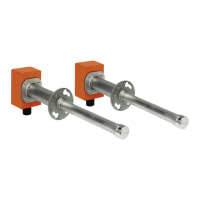44 FLOWSIC100 · Operating Instructions · 8012513/YSA5/V2-1/2016-07 · © SICK Engineering GmbH
Product Description
Subject to change without notice
2.4 Computations
2.4.1 Calculating and calibrating the volume flow
Volume flow in operating state
Acoustic velocity monitors from the FLOWSIC100 series are usually used to determine the
volume flow in closed pipes and ducts. The volume flow Q
a.c.
through the representative
cross-sectional area A and the mean gas flow rate across the cross-section v
A
(area
velocity) is defined as:
Q
act.
= v
A
· A
The FLOWSIC100, however, determines the representative mean value of the flow velocity
on a sound path v (path velocity) between the two sender/receiver units. The sound path is
generally arranged across the diameter (
p. 51, 3.1.1).
Since the mean values of the path and area velocity are not identical (particularly in small
duct diameters), a functional, systematic correlation between the calculated path velocity
and the mean area velocity similar to the point-based flow measurement (for example, a
pitot tube probe) has been introduced.
v
A
= K · v K = correction function
The correction factor k can be used for K with unimpeded, axial-symmetric flow profiles in
round pipes.
0.9 < k < 1
In many cases, however, an unimpeded, axial-symmetric flow profile is not guaranteed due
to the installation conditions (short inlet sections, rectangular ducts, unsymmetrical flow
profiles, and so on). For this reason, a second degree calibration function has been
implemented in FLOWSIC to show the relation between middle path and area velocity.
v
A
= Cv_2 · v
2
+ Cv_1 · v + Cv_0
The coefficients in this calibration function can be determined by means of network
measurements and regression analysis (see DIN EN 13284-1). The calculated regression
coefficients must then be entered in the measuring device using SOPAS ET (
p. 151, 4.3.6).
Default values from the factory are Cv2 = 0, Cv1 = 1, Cv0 = 0.
If the flow in a round pipeline is unimpeded and axial-symmetric, Cv_1 is
equal to the correction factor k.

